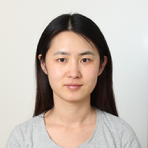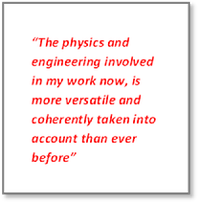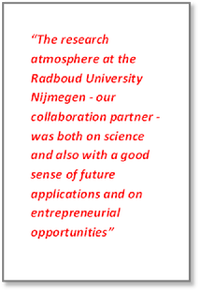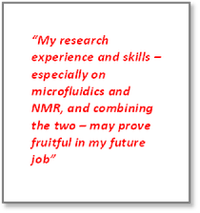 In this thesis the main goal was to develop a stripline-based microfluidic device for on-chip microscale Nuclear Magnetic Resonance (NMR) spectroscopy.
In this thesis the main goal was to develop a stripline-based microfluidic device for on-chip microscale Nuclear Magnetic Resonance (NMR) spectroscopy.
‘This method has great potential, especially when mass and volume of samples are limited, for example when metabolites, natural products are involved,’ says Hainan Zhang. ‘In this lab-on-a-chip application the spectral resolution is maintained for small volumes, in some cases even increased as compared with conventional NMR.’
Apart from the capability of detecting very minute amounts in medical samples, with its high spectral resolution and mass sensitivity this system is promising for chemical analyses as well.
In-line monitoring of catalytic styrene hydrogenation (over a heterogeneous palladium catalyst) was demonstrated at various hydrogen pressures. Further: the feasibility of this stripline-based microfluidic NMR probe, was described for detecting ‘structures’ in mass-limited complex mixtures, in which polycyclic aromatic hydrocarbons were partially reduced in ethanol.
‘The scope which we worked in started from several tens of nanoliters up to several hundred,’ Hainan says. ‘The resolutions were high. We could detect signal variations below several Hertz within limited sample sizes.’

Design, fabrication and optimization aspects were involved in this thesis aimed at effective ways to enhance NMR’s mass sensitivity, by using miniaturized radio frequency (RF) coils in these special lab-on-a-chip probes.
‘By doing so the coupling of the sample to the RF circuitry is improved,’ Hainan explains. ‘During the PhD I developed greatly as a researcher because of the multiple disciplines that are requisite. Compared to my master project – on microfluidics as well – I now know quite a bit more on NMR. And the physics and engineering involved is more versatile and coherently taken into account than ever before.’
Collaboration

The collaboration with the Solid-state NMR group of Radboud University Nijmegen, Hainan appreciated especially.
‘Their expertise on medical, chemical and physical applications is a vast one,’ she says. ‘They helped me on finding answers and research strategies in this complex field: from the first modeling stages – for example on the dimensions of the coils – up to designing novel measurement strategies and testing of the actual probes. The research atmosphere in Nijmegen was both on science and also with a good sense of future applications and on entrepreneurial opportunities.’
Cleanroom

The microcoils with a length of 3-9 millimeters and width of 300-500 micrometers, were fabricated in the Mesa+ Nanolab cleanroom. ‘From the very first day, as my promoter Professor Han Gardeniers showed me around, I was impressed by the up-to-date equipment available at Mesa+. In our Group everyone works in the cleanroom and is willing to share his expertise. PhD colleagues and technicians were of great added value as to the final results of my work.’
Future
Hainan: ‘After my Defense, I plan to return to my native country China. After spending already several years in academics, I would like to change and work in industry, learning new things. I guess the way problems are solved and research is planned, is different in industry as it was in my work here. I am curious to learn about that.’

‘My research experience and skills – especially on microfluidics and NMR, and combining the two – may prove fruitful in my future job. By bringing in creative and novel ideas, I hope to contribute to the development of Chinese companies. When the knowledge base is broadened, more companies will be able to come to the market with innovative products. This, in my view, is important for China to develop as a strong economic country.’
